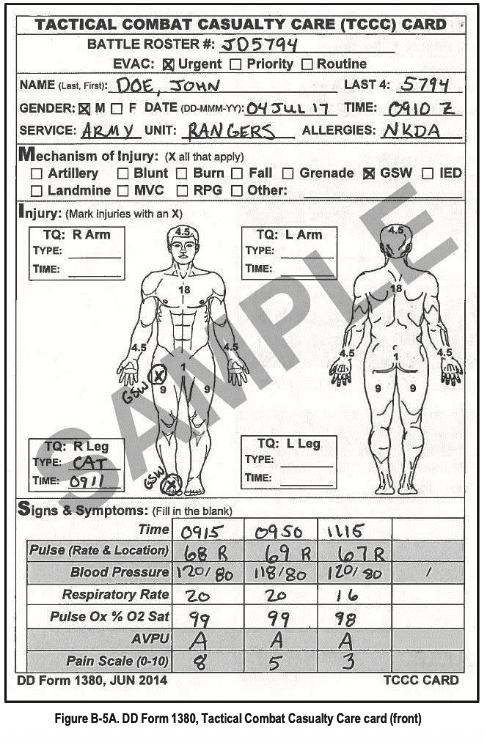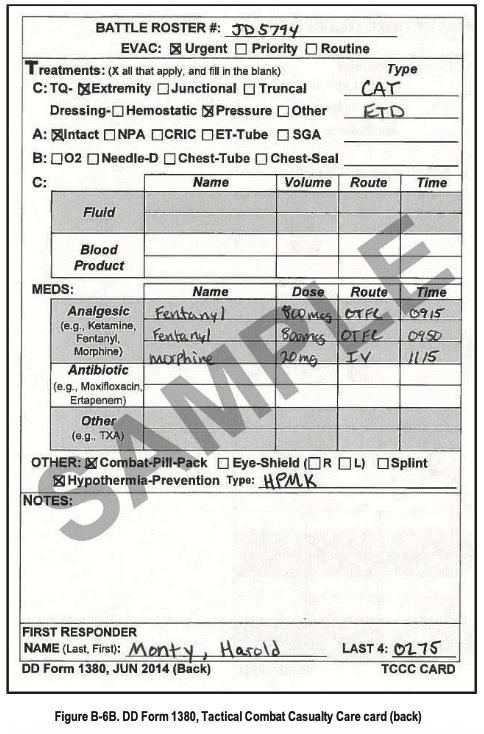9 Line MEDEVAC
BREAK BREAK BREAK
Reference: TC 3-21.76 (Ranger Handbook)

Overview
During patrols, you may encounter friendly casualties and need to request a medical evacuation. The 9 Line MEDEVAC is the standard format to request evac of personnel.
Structure
The 9 Line request is transmitted one line at a time. Lines 1–5 are required to launch the aircraft; Lines 6–9 can be sent while the aircraft is en route. Transmit with 100% accuracy and use proper phonetics. Always pronounce numbers digit-by-digit (e.g., “fife” for 5, “tree” for 3).
Line 1 – Location of Pickup Site
8-digit grid coordinates of the pickup site (include grid-zone designator to avoid confusion). Example: “Echo Golf three two three four five five four four” (EG 3234 5544)
Line 2 – Radio Frequency, Call Sign, and Suffix
Frequency of the radio at the pickup site + call sign (and suffix if used) of the person to be contacted. The RTO provides this info beforehand. Example: “Three fife zero zero, Trident tree” (3500)
Line 3 – Number of Patients by Precedence
- A – URGENT (within 2 hours)
- B – URGENT (requires surgical care)
- C – PRIORITY (within 4 hours)
- D – ROUTINE (within 24 hours)
- E – CONVENIENCE
Insert “BREAK” between categories. Example: “Two Alpha, BREAK, one Charlie”
Line 4 – Special Equipment Required
- A – None
- B – Hoist
- C – Extraction equipment
- D – Ventilator
Example: “Charlie”
Line 5 – Number of Patients by Type
- L + number – Litter (cannot walk)
- A + number – Ambulatory (can sit/walk)
Insert “BREAK” between litter and ambulatory. Example: “Lima two, BREAK, Alpha one”
Line 6 – Security of Pickup Site (Wartime)
- N – No enemy troops in area
- P – Possible enemy troops
- E – Enemy troops in area (approach with caution)
- X – Enemy troops in area (armed escort required)
Line 6 – Number and Type of Wound, Injury, or Illness (Peacetime)
Specific info (e.g., “gunshot wound to chest”).
Line 7 – Method of Marking Pickup Site
- A – Panels (VS-17)
- B – Pyrotechnic signal
- C – Smoke signal
- D – None
- E – Other
Line 8 – Patient Nationality and Status
No need to indicate number of personnel per category
- A – U.S. Military
- B – U.S. Civilian
- C – Non-U.S. Military
- D – Non-U.S. Civilian
- E – Enemy Prisoner of War
Example: “Alpha, BREAK, Bravo”
Line 9 – CBRN Contamination (Wartime)
- C – Chemical
- B – Biological
- R – Radiological
- N – Nuclear
Transmit only if applicable
Line 9 – Terrain Description (Peacetime)
Describe landing zone features (e.g., “open field, 50m x 50m, power lines to the north”).
TCCC Card
Most 9 Line info comes from the TCCC (Tactical Combat Casualty Care) card filled out by the combat lifesaver or medic.


Putting It All Together – Full Example
You are Trident 3. You have casualties after contact.
You: “Redbird Main, this is Trident tree, BREAK BREAK BREAK, 9 Line MEDEVAC, over.” Redbird Main: “Trident tree, send it.”
You: “Line 1: Echo Golf three two three four, fife fife four four, over.” “Line 2: Three fife zero zero, Trident tree, over.” “Line 3: Two Alpha, BREAK, one Charlie, over.” “Line 4: Charlie, over.” “Line 5: Lima two, BREAK, Alpha one, over.”
(Wait for aircraft en route, then continue)
“Line 6: Echo, over.” “Line 7: Alpha, over.” “Line 8: Alpha, BREAK, Bravo, over.” “Line 9: November, over.”
Redbird Main: “Trident tree, roger, aircraft inbound, ETA one five minutes, out.”
Here is a video to see it in action
Tip
Lines 1–5 must be transmitted within 25 seconds of initial contact. Lines 6–9 can be sent while the aircraft is en route.
Closing
Calling a 9 Line isn’t hard once you practice. Keep a cheat sheet laminated in your kit. Here’s a printable version: